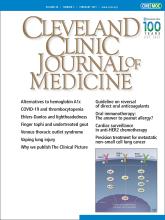Article Figures & Data
Tables
Studya Year No. of patients Duration (years) Early vs metastatic Anthracycline Follow-up (years) Echocardiography result LVEF drop (%) Heart failure incidence (%) Cardiac death (%) OHERA7 2019 3,733 1 Early Yes 5 4+ 2 3 < 1 KATHERINE8 2019 1,486 0.4 Early No 5 4+ NA NA 0 NSABP9 2017 407 1 Early Yes 5 4+ 1 NA < 1 HERA10 2017 5,099 1–2 Early No 10 4+ < 1 NA NA APHINITY11 2017 4,805 1 Early No 10 5+ NA < 1 < 1 Dang et al12 2016 406 1 Both No 4 4+ 3 < 1 NA HORG13 2015 481 1 Early No 7 3+ < 1 0 0 CLEOPATRA14 2013 804 1 Both No 3 3+ 1 < 1 < 1 NeoSphere15 2012 417 0.4 Both No 2 weeks 3+ < 1 < 1 0 BCIRG-00616 2011 3,222 1 Both Yes 5 7+ 14 < 1 0 Slamon et al6,b 2001 234 0.8 Metastatic Yes > 2 NA 16 27 0 ↵a All trials included radiation therapy and were adjudicated.
↵b Pivotal trial leading to stringent US Food and Drug Administration recommendations for cardiac surveillance.
APHINITY = A Study of Pertuzumab in Addition to Chemotherapy and Trastuzumab as Adjuvant Therapy in Participants With Human Epidermal Growth Receptor 2 (HER2)-Positive Primary Breast Cancer; BCIRG = Breast Cancer International Research Group; CLEOPATRA = A Study to Evaluate Pertuzumab + Trastuzumab + Docetaxel vs. Placebo + Trastuzumab + Docetaxel in Previously Untreated HER2-Positive Metastatic Breast Cancer; HER2 = human epidermal growth factor receptor 2; HERA = HERceptin Adjuvant; HORG = Hellenic Oncology Research Group; KATHERINE = A Study of Trastuzumab Emtansine Versus Trastuzumab as Adjuvant Therapy in Patients With HER2-Positive Breast Cancer Who Have Residual Tumor in the Breast or Axillary Lymph Nodes Following Preoperative Therapy; LVEF = left ventricular ejection fraction; NA = not available; NeoSphere = A Study of Pertuzumab in Combination With Herceptin in Patients With HER2 Positive Breast Cancer; NSABP = National Surgical Adjuvant Breast and Bowel Project; OHERA = Observational Study of Cardiac Events in Patients with HER2-Positive EBC Treated with Herceptin
- TABLE 2
Wilson’s criteria for an ideal screening test, applied to cardiac surveillance for chemotherapy
Criteria24 Surveillance echocardiography for chemotherapy The condition should be an important health problem Cardiotoxicity is an important health problem but is detectable by screening only in a minority of patients The natural history of the condition should be understood The natural history of cardiotoxicity has been reasonably well studied for established chemotherapy agents such as anti-HER2 There should be a recognizable latent or early symptomatic stage Left ventricular dysfunction typically relates to acute toxicity and becomes manifest within the first year of exposure. Early recognition is important, because cumulative doses typically compound toxicity A test should exist that is easy to perform and interpret, and is acceptable, accurate, reliable, sensitive, and specific Imaging with echocardiography has these qualities but also involves considerable challenges and limitations An accepted treatment for the disease should exist Current guideline-directed heart failure management is recognized as treatment for chemotherapy-related cardiomyopathy. Evidence is limited for specific treatments beyond these guidelines, although the subject is under active investigation Treatment should be more effective if started early If started early, current guideline-directed heart failure management is considered to be more effective. Early recognition of chemotherapy-related cardiomyopathy is important for preventing additional dose exposures, which typically compound toxicity There should be a policy on who should be treated Current guideline-directed heart failure management covers who should be treated Diagnosis and treatment should be cost-effective Limited data suggest favorable cost-effectiveness for screening and early treatment, although a more targeted approach can likely significantly improve it Case-finding should be a continuous process Case-finding can be a continuous process






